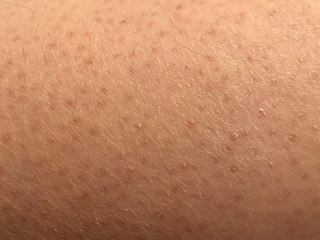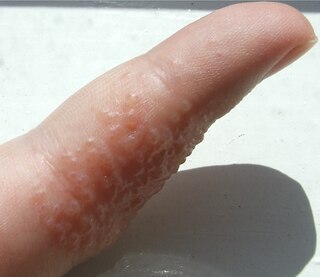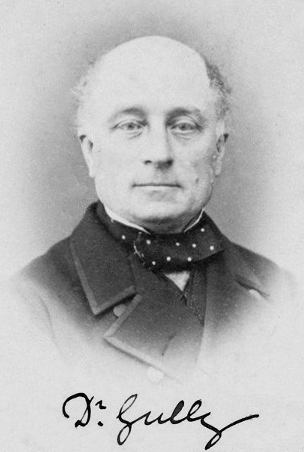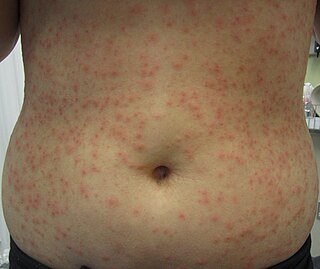Related Research Articles

Porphyria is a group of disorders in which substances called porphyrins build up in the body, adversely affecting the skin or nervous system. The types that affect the nervous system are also known as acute porphyria, as symptoms are rapid in onset and short in duration. Symptoms of an attack include abdominal pain, chest pain, vomiting, confusion, constipation, fever, high blood pressure, and high heart rate. The attacks usually last for days to weeks. Complications may include paralysis, low blood sodium levels, and seizures. Attacks may be triggered by alcohol, smoking, hormonal changes, fasting, stress, or certain medications. If the skin is affected, blisters or itching may occur with sunlight exposure.

The crab louse or pubic louse is an insect that is an obligate ectoparasite of humans, feeding exclusively on blood. The crab louse usually is found in the person's pubic hair. Although the louse cannot jump, it can also live in other areas of the body that are covered with coarse hair, such as the perianal area, the entire body, and the eyelashes.

Ehlers–Danlos syndromes (EDS) are a group of 13 genetic connective-tissue disorders. Symptoms often include loose joints, joint pain, stretchy velvety skin, and abnormal scar formation. These may be noticed at birth or in early childhood. Complications may include aortic dissection, joint dislocations, scoliosis, chronic pain, or early osteoarthritis. The current classification was last updated in 2017, when a number of rarer forms of EDS were added.
Delusional parasitosis (DP), also called delusional infestation, is a mental health condition where a person falsely believes that that their body is infested with living or nonliving agents. Common examples of such agents include parasites, insects, or bacteria. This is a delusion due to the belief persisting despite evidence that no infestation is present. People with this condition may have skin symptoms such as the urge to pick at one's skin (excoriation) or a sensation resembling insects crawling on or under the skin (formication).Morgellons disease is a related constellation of symptoms. This self-diagnosed condition is considered a form of a type of delusional parasitosis. People with Morgellons falsely believe harmful fibers are coming out of their skin and causing wounds.

Lamellar ichthyosis, also known as ichthyosis lamellaris and nonbullous congenital ichthyosis, is a rare inherited skin disorder, affecting around 1 in 600,000 people.

Keratosis pilaris is a common, autosomal-dominant, genetic condition of the skin's hair follicles characterized by the appearance of possibly itchy, small, gooseflesh-like bumps, with varying degrees of reddening or inflammation. It most often appears on the outer sides of the upper arms, thighs, face, back, and buttocks; KP can also occur on the hands, and tops of legs, sides, or any body part except glabrous (hairless) skin. Often the lesions can appear on the face, which may be mistaken for acne or folliculitis.

Formication is the sensation resembling that of small insects crawling on the skin, in the absence of actual insects. It is one specific form of a set of sensations known as paresthesias, which also include the more common prickling, tingling sensation known as pins and needles. Formication is a well-documented symptom which has numerous possible causes. The word is derived from formica, the Latin word for ant.

For much of his adult life, Charles Darwin's health was repeatedly compromised by an uncommon combination of symptoms, leaving him severely debilitated for long periods of time. However, Darwin himself suggested that, in some ways, this may have helped his work: "Even ill-health, though it has annihilated several years of my life, has saved me from the distractions of society and amusement."

Dyshidrosis is a type of dermatitis, characterized by itchy vesicles of 1–2 mm in size, on the palms of the hands, sides of fingers, or bottoms of the feet. Outbreaks usually conclude within three to four weeks, but often recur. Repeated attacks may result in fissures and skin thickening. The cause of the condition is not known.
Vulvitis is inflammation of the vulva, the external female mammalian genitalia that include the labia majora, labia minora, clitoris, and introitus. It may co-occur as vulvovaginitis with vaginitis, inflammation of the vagina, and may have infectious or non-infectious causes. The warm and moist conditions of the vulva make it easily affected. Vulvitis is prone to occur in any female especially those who have certain sensitivities, infections, allergies, or diseases that make them likely to have vulvitis. Postmenopausal women and prepubescent girls are more prone to be affected by it, as compared to women in their menstruation period. It is so because they have low estrogen levels which makes their vulvar tissue thin and dry. Women having diabetes are also prone to be affected by vulvitis due to the high sugar content in their cells, increasing their vulnerability. Vulvitis is not a disease, it is just an inflammation caused by an infection, allergy or injury. Vulvitis may also be symptom of any sexually transmitted infection or a fungal infection.

James Manby Gully was a Victorian medical doctor, well known for practising hydrotherapy, or the "water cure". Along with his partner James Wilson, he founded a very successful "hydropathy" clinic in Malvern, Worcestershire, which had many notable Victorians, including such figures as Charles Darwin and Alfred, Lord Tennyson, as clients.
Fox–Fordyce disease (FFD) is a chronic blockage of the sweat gland ducts with a secondary, non-bacterial inflammatory response to the secretions and cellular debris in the cysts. The inflammation is often accompanied by intense itching. In general, the disease often causes skin to darken near the affected area and raised bumps or papules to appear. In addition, hair follicles can become damaged which cause hair loss. Hidradenitis is very similar, but tends to have a secondary bacterial infection so that pus-draining sinuses are formed. It is a very devastating skin disease that does not have universally curative treatments.

Dermatopathia pigmentosa reticularis(DPR) is a rare, autosomal dominant congenital disorder that is a form of ectodermal dysplasia. Dermatopathia pigmentosa reticularis is composed of the triad of generalized reticulate hyperpigmentation, noncicatricial alopecia, and onychodystrophy. DPR is a non life-threatening disease that largely affects the skin, hair, and nails. It has also been identified as a keratin disorder. Historically, as of 1992, only 10 cases had been described in world literature; however, due to recent advances in genetic analysis, five additional families studied in 2006 have been added to the short list of confirmed cases.

Hot tub folliculitis, also called Pseudomonalfolliculitis or Pseudomonas aeruginosa folliculitis, is a common type of folliculitis featuring inflammation of hair follicles and surrounding skin.
Oculocutaneous albinism type I or type 1A is form of the autosomal recessive condition oculocutaneous albinism that is caused by a dysfunction in the gene for tyrosinase.
Morgellons is the informal name of a self-diagnosed, scientifically unsubstantiated skin condition in which individuals have sores that they believe contain fibrous material. Morgellons is not well understood, but the general medical consensus is that it is a form of delusional parasitosis, on the psychiatric spectrum. The sores are typically the result of compulsive scratching, and the fibers, when analysed, are consistently found to have originated from cotton and other textiles.
The history of dermatology concerns the development of the practice of researching, defining and treating skin diseases, from ancient times to the present. The field has its origin in the earliest forms of medicine, later becoming a distinct field with its own specialised practitioners and researchers.
The International Lyme and Associated Diseases Society is a non-profit advocacy group which advocates for greater acceptance of the controversial and unrecognized diagnosis "chronic Lyme disease". ILADS was formed by advocates for the recognition of "chronic Lyme disease" including physicians, patients and laboratory personnel, and has published alternative treatment guidelines and diagnostic criteria due to the disagreement with mainstream consensus medical views on Lyme disease.
Chronic Lyme disease (CLD) is the name used by some people with non-specific symptoms, such as fatigue, muscle pain, and cognitive dysfunction to refer to their condition, even if there is no evidence that they had Lyme disease. Both the label and the belief that these people's symptoms are caused by this particular infection are generally rejected by medical professionals. Chronic Lyme disease is distinct from post-treatment Lyme disease syndrome, a set of lingering symptoms which may persist after successful antibiotic treatment of infection with Lyme-causing Borrelia bacteria, and which may have similar symptoms to those associated with CLD.
References
- ↑ "The Major Works of Sir Thomas Browne", edited and with an Introduction by C. A. Partides. Penguin 1977
- ↑ "Sir Thomas Browne's A Letter to a Friend". penelope.uchicago.edu. Retrieved 2019-04-21.
- ↑ Ferreira, Bárbara Roque; Roccia, Maria Grazia; Cardoso, José Carlos; França, Katlein; Wollina, Uwe; Lotti, Torello; Fioranelli, Massimo (October 2017). "History of Morgellons disease: the same name for different psychodermatologic diseases?". Wiener Medizinische Wochenschrift. 167 (S1): 49–51. doi:10.1007/s10354-017-0552-8. PMID 28299553.
- ↑ "OBITUARY". British Medical Journal. 2 (6146): 1234–1235. 28 October 1978. doi:10.1136/bmj.2.6146.1234. PMC 1608351 .
- ↑ "The Morgellons". penelope.uchicago.edu. Retrieved 2019-04-21.